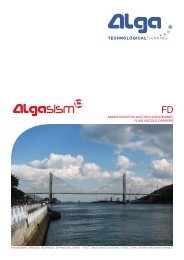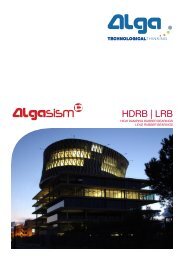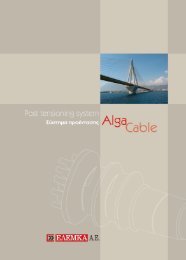ALGA GENERAL CATALOGUE
ALGA GENERAL CATALOGUE
ALGA GENERAL CATALOGUE
Create successful ePaper yourself
Turn your PDF publications into a flip-book with our unique Google optimized e-Paper software.
Il ponte Vasco da Gama a Lisbona, Portogallo, lungo 12,3 km è una delle più importanti opero<br />
recentemente costruite in Europa. Esso utilizza appoggi Algapot, dei quali alcuni iniettabili ed<br />
alcuni con scorrimento di oltre 5 metri (vedi foto a lato).<br />
Apparecchi d’appoggio<br />
Agli occhi del profano i ponti e le grandi strutture dell’ingegneria civile appaiono<br />
come opere statiche che sfi dano la forza di gravità e le ingiurie del<br />
tempo con la loro immobilità e robustezza. Nulla di più errato: come l’ingegnere<br />
strutturista ben sa le strutture si deformano, si fl ettono o si torcono<br />
per effetto dei carichi ad esse applicate, e variano la loro lunghezza per<br />
effetto dei cambiamenti di temperatura o per fenomeni lenti connessi con la<br />
maturazione di materiali come il calcestruzzo.<br />
Gli apparecchi d’appoggio sono quei dispositivi strutturali che permettono<br />
la corretta trasmissione dei carichi consentendo tutti i movimenti relativi –<br />
spostamenti e rotazioni – fra gli elementi di struttura che connettono. In conformità<br />
con la defi nizione che ne dà la norma europea EN1337 “gli appoggi<br />
sono dispositivi che consentono la rotazione fra due elementi strutturali e<br />
trasmettono i carichi richiesti impedendo qualsiasi spostamento (appoggi<br />
fi ssi), o consentono lo spostamento in una sola direzione (appoggi mobili<br />
unidirezionali), o in tutte le direzioni di un piano (appoggi mobili multidirezionali)”.<br />
Alga è sempre stata all’avanguardia nel campo degli apparecchi d’appoggio<br />
ed il suo Amministratore delegato Ing. Agostino Marioni è il principale<br />
artefi ce della normativa Europea EN 1337 di cui è il Chairman fi n dall’inizio<br />
dei lavori.<br />
Sono disponibili le seguenti tipologie di apparecchi d’appoggio: <strong>ALGA</strong>POT<br />
Appoggi a disco elastomerico; SFERON Appoggi sferici; LINEAR Appoggi<br />
a contatto lineare; <strong>ALGA</strong>BLOC Appoggi in gomma; <strong>ALGA</strong>FLON Appoggi<br />
in gomma e PTFE; EBP Appoggi antivibranti; FSK e MSK Chiavi di taglio<br />
fi sse e mobili;<br />
Apparecchi d’appoggio speciali: strumentati, iniettabili, a doppio effetto,<br />
dielettrici, antivibranti.<br />
<strong>ALGA</strong> utilizza per i propri appoggi anche i materiali di scorrimento innovativi:<br />
• XLIDE che garantisce resistenza all’usura 5 volte superiore al PTFE e resistenza<br />
a compressione doppia<br />
• HOTSLIDE che permette le applicazioni nei climi ove si superino i 48°C,<br />
e fi no a 100°C.<br />
Sperimentazione e controllo di qualità<br />
La messa a punto di questi dispositivi ed altri prodotti dalla Società <strong>ALGA</strong> è<br />
stata possibile grazie ai notevoli investimenti in ricerca e sviluppo effettuati<br />
negli ultimi anni. La vendita di questi prodotti è soggetta ad un controllo di<br />
qualità molto rigoroso, effettuato in base alla normativa ISO 9001 in modo<br />
da poter garantire all’utilizzatore le prestazioni dichiarate e la durabilità che<br />
comunque non è mai inferiore a 60 anni.<br />
The Vasco da Gama bridge in Lisbon, Portugal, with its 12,3 km length, is one of the most important<br />
bridges recently built in Europe. It utilizes Algapot bearings, some of them injectable and<br />
some with horizontal displacement over 5 meter (see the picture aside).<br />
Apparecchi d’appoggio<br />
To the eyes of a profane observer, bridges and large civil engineering structures<br />
seems like static works, withstanding gravity and environmental effects<br />
thanks to their fi xity and stiffness. Nothing could be wrong more than that:<br />
as the structural engineer well knows all structures are deforming, defl ecting<br />
or twisting under the effect of the superimposed loads, furthermore they<br />
vary their length due to temperature variations, creep and shrinkage of the<br />
concrete.<br />
Structural bearings indeed are the devices allowing the correct transfer of<br />
the loads between the structural members, permitting at the same time all<br />
the necessary relative movements, translations and rotations. In accordance<br />
with the defi nition given by the European Standard EN 1337 “Bearings are<br />
elements allowing rotation between two members of a structure and transmitting<br />
the loads defi ned in the relevant requirements as well as preventing<br />
displacements (fi xed bearings), allowing displacements in only one direction<br />
(guided bearings) or in all directions of a plane (free bearings) as required”.<br />
<strong>ALGA</strong> has always been a vanguard in the fi eld of structural bearings and<br />
its Managing Director Dr. Ing. Agostino Marioni is the main creator of the<br />
European Standard EN 1337, being its Chairman since the beginning of the<br />
works.<br />
The following Bearing types are available: <strong>ALGA</strong>POT Pot Bearings; SFER-<br />
ON Spherical Bearings; LINEAR Rocker Bearings; <strong>ALGA</strong>BLOC Elastomeric<br />
Bearings; <strong>ALGA</strong>FLON Elastomeric Bearings with PTFE; EBP Antivibrating<br />
Bearings; FSK e MSK Fixed and Movable Shear Keys; Special bearings:<br />
with monitoring instruments, injectable, double acting, dielectric are also<br />
available.<br />
<strong>ALGA</strong> utilizes for the bearings also innovative sliding materials:<br />
• XLIDE granting a wear resistance more than 5 times and a compressive<br />
strength more than twice that of PTFE<br />
• HOTSLIDE suitable for applications with temperatures exceeding 48°C<br />
(limit temperature for PTFE) and up to 100°C<br />
Research and quality control<br />
The development of innovative bearings was made possible by the great<br />
investments in research and the strict contact with the main European research<br />
centres like Politecnico di Milano.<br />
All structural bearings are subject to quality assurance according to ISO<br />
9001 and, where applicable to CE marking according to EN 1337







